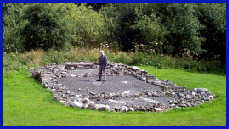
Early Christianity in Wales 3
Life in the monasteries
Failed ideals
The earlier saints’ lives paint a picture of a more dedicated
ascetic monastic life but Gildas’ work gives us a picture
of communities of monks who failed to live up to this aspiration,
living in comfort and failing to help the poor. Rhigyfarch’s
eleventh century life of St David does give a clear picture of
the long standing rules associated with the cult of the saint.
These involve a cloistered and isolated  life of poverty with limited conversation
and diet and total obedience to the abbot. This may well have
been the ideal life to which monks were encouraged to aspire
but how far it was the norm in pre-conquest Wales is open to
doubt.
life of poverty with limited conversation
and diet and total obedience to the abbot. This may well have
been the ideal life to which monks were encouraged to aspire
but how far it was the norm in pre-conquest Wales is open to
doubt.
Early records do mention bishops and priests and the practises of baptism and Christian burial, but a parish-based system of priests ministering to lay congregations is not recorded until the twelfth century. There may well have been Christian cemeteries at Capel Maelog in Radnorshire (above) and at Pennant Melangell in Montgomeryshire (pictured on the previous page) before the churches there were founded, and it may be that the Christian population of pre-Conquest Wales did not have access to regular worship but were baptised and buried by members of the monastic communities who would perhaps also occasionally undertake preaching tours through the land.
There are 3 pages on early Christianity in Wales. Use the box links below to view the other pages.